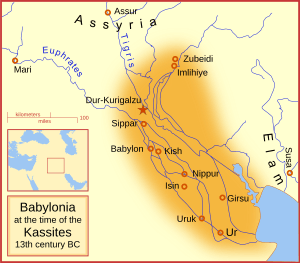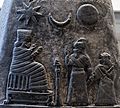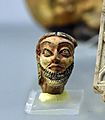Kassite dynasty facts for kids
The Kassite dynasty was a powerful group of rulers in ancient Babylon. They were a mountain tribe who took control of Babylonia around 1595 BC. This happened after the city of Babylon was attacked by the Hittites. The Kassites then became the main rulers of northern Babylonia.
Contents
Who Were the Kassites?
The Kassites were an ancient people from the Zagros Mountains. These mountains are found in what is now Iran. The Kassites were made up of different nomadic tribes. They moved around a lot in the Zagros Mountains.
Around the 18th century BCE, the Kassites began to move into Mesopotamia. This land was ruled by the kings who came after the famous king Hammurabi of Babylon. The Kassites became a threat to Babylonia. They finally captured the region in 1750 BC.
The Kassite dynasty ruled Mesopotamia for a long time. They were in charge from the 16th to the 12th century BC.
Why Was the Kassite Empire Important?
The Kassites changed southern Mesopotamia into a single state. Before them, it was just a group of separate temple-cities. This made Babylonia a strong international power. They ruled Babylonia for about 400 years. This was the longest rule by any dynasty in Babylonian history.
Trade and Diplomacy
Kassite kings made friends and traded with other powerful lands. These included Assyria, Egypt, Elam, and the Hittites. The royal families of the Kassites even married into these other royal families.
Many foreign merchants came to Babylon and other cities. Babylonian merchants traded with places like Egypt, which had gold. They also traded with Assyria and Anatolia. Kassite weights and seals, which were used for trade, have been found far away. They were found in Thebes in Greece and in southern Armenia. Some were even found in a shipwreck near modern Turkey.
How the Kassites Governed
The Kassite kings set up a system of provinces. These were like different regions, each run by a governor. Nippur was once a great city, but it had been almost empty. The Kassites rebuilt Nippur. It became the most important provincial center.
Under the Kassite government, the governor of Nippur acted like a smaller king. Some Kassite kings from the 13th century BC even called themselves 'Governor of Nippur'.
The End of the Kassite Rule
The Elamites conquered Babylonia in the 12th century BC. This brought an end to the Kassite state. The last Kassite king, Enlil-nadin-ahi, was taken to Susa. He was put in prison there and later died.
However, the Kassites as a people did not disappear. They continued to live as a distinct group in the mountains of Lorestan. This was long after their empire had fallen.
Images for kids
-
Kassite Kudurru stele of Kassite king Marduk-apla-iddina I. Louvre Museum.
-
Kassite king Meli-Shipak II on a kudurru land grant presenting his daughter Ḫunnubat-Nanaya to the goddess Nanaya (pictured enthroned). The eight-pointed star seen above was Inanna-Ishtar's most common symbol. Here it is shown alongside the solar disk of her brother Shamash (Sumerian Utu) and the crescent moon of her father Sin (Sumerian Nanna) on a boundary stone of Meli-Shipak II, dating to the twelfth century BC.
-
Babylonian Kudurru stele of the late Kassite period, in the reign of Kassite king Marduk-nadin-akhi (ca. 1099–1082 BC). Found near Baghdad by the French botanist André Michaux (Cabinet des Médailles, Paris)
-
Winged centaur hunting animals. Kassite period. Louvre Museum, reference AO 22355
See also
 In Spanish: Dinastía Casita para niños
In Spanish: Dinastía Casita para niños



















